Serious Compacts contributor Wouter Brandsma has posted his extended use impressions of the Ricoh GR Digital III over at his personal blog. Be sure to have a read to get his insights about this exciting camera and see some great photographs!
Link: Wouter photoblog - 'My final Ricoh GR Digital III impressions'
GRD III Impressions / Review at Wouter Brandsma Photography
Wednesday, September 30, 2009
Posted by Amin
![]() Labels:
Canon G10 Review,
GRD III,
GRD3,
Ricoh GRD III
Labels:
Canon G10 Review,
GRD III,
GRD3,
Ricoh GRD III
Face Detection
Sunday, September 27, 2009
As cameras get progressively loaded with new features, there will naturally be some push back from the old-fashioned types who enjoy the "authentic" photographic experience of manually controlling everything. Face detection may best exemplify the new wave of features which so many of us have smugly dismissed as useless. However, as Björn Utpott recently suggested, it's difficult to argue against the usefulness of face detection when one has experienced a good implementation of it.
Here's a simple example. I mounted the Zuiko 17mm lens on the Panasonic GH1 in 'P' mode and snapped four photos, two in 'Dynamic B&W' mode and two in 'Standard' (color). All were in camera JPEGs with automatic exposure. On the left, you can see the results using face detection. On the right are the results using center point AF to focus on my wife, followed by recomposition.

Sure, the same can be easily accomplished the same without face detection. One can judge the lighting and dial in exposure compensation on just about any camera. Some cameras will allow spot metering, which can accomplish much the same, and still others allow customization in how metering is linked to focus points. However, there is a beautiful simplicity to having the camera automatically properly expose any detected faces in the frame.
I'm not yet sure where features like face detection fit for me. I'll always enjoy the fully manual experience, but new features like face detection have their place. I expect that DVIL (direct view interchangeable lens) cameras will continue to lead the way in implementing these technologies.
Posted by Amin
![]() Labels:
DVIL,
face detection
Labels:
DVIL,
face detection
Panasonic Lumix 20mm f/1.7 Review at DPReview
Friday, September 25, 2009
DPReview has published their review of the Lumix 20mm f/1.7, which is arguably one of the most important lens releases ever for any camera system. It is one of DPR's finest lens reviews yet in my opinion. Check it out here. Read More......
Posted by Amin
![]() Labels:
20mm,
40mm,
Lumix 20/1.7,
Panasonic 20/1.7
Labels:
20mm,
40mm,
Lumix 20/1.7,
Panasonic 20/1.7
Featured Photographer: Vern Dewit
Wednesday, September 23, 2009
While browsing the 'Buy and Sell' forum at Fred Miranda, I came across a thread which began, "Due to my never ending quest for the perfect hiking / mountaineering camera I am selling my GH1 in anticipation of my new GF1 and the recent acquiring of an Olympus EP1". After seeing the photographs in that thread started by Vern Dewit, I went and had a look at his Zenfolio gallery and asked to feature his work on Serious Compacts.
Vern lives in Calgary, Alberta, Canada, and enjoys spending time outdoors in the Rocky Mountains west of the city. Looking at his photography, it's easy to see why. A few of his recent photographs, all taken with the GH1 (and various Micro Four Thirds kit lenses) are shown below. Click a photo to view a larger version.






You can see more of Vern Dewit's photography at http://verndewit.com. If you'd like to buy his GH1, which was used to make most of the photographs in his '2009 Favorites' collection, see the Fred Miranda thread here.
Posted by Amin
![]() Labels:
featured,
Vern Dewit
Labels:
featured,
Vern Dewit
Sigma DP2 Shootout Supplement: Bokeh
For bokeh (out-of-focus blur rendering) tests, I usually like to have a second lens for comparison. However, I currently lack another 40mm equivalent lens to compare with the DP2 lens, so I'll just provide some bokeh samples to give an idea of how the DP2 lens renders out-of-focus blurred areas. Unlike lens sharpness, one can get a sense of bokeh from images resized for the web. I'll point out a few other concerns in specific examples.
F/2.8:
While the DP2 lens has decent flare resistance, it flares more than the DP1 lens in my experience. The above photo shows flare with a stong off-axis light source. The hood was employed, and no filter was present. You can also see a blue-green discoloration on the wall in the upper right aspect of the frame.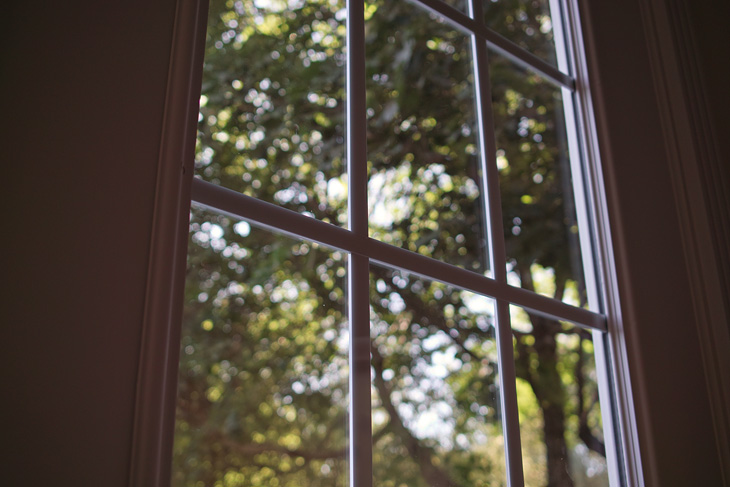
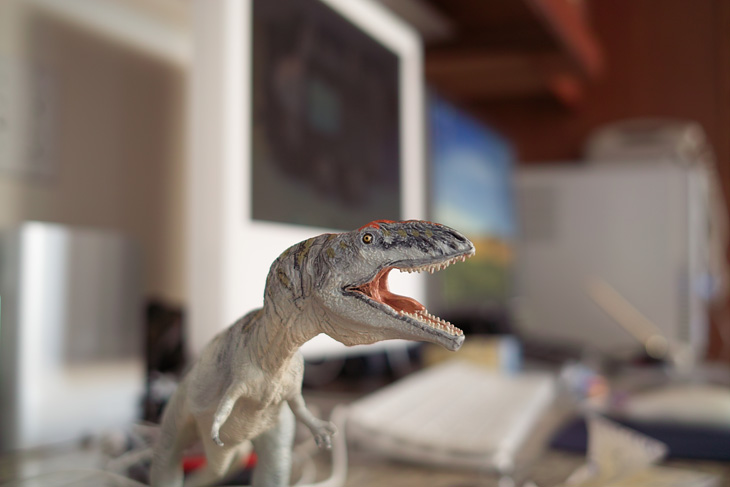
F/4: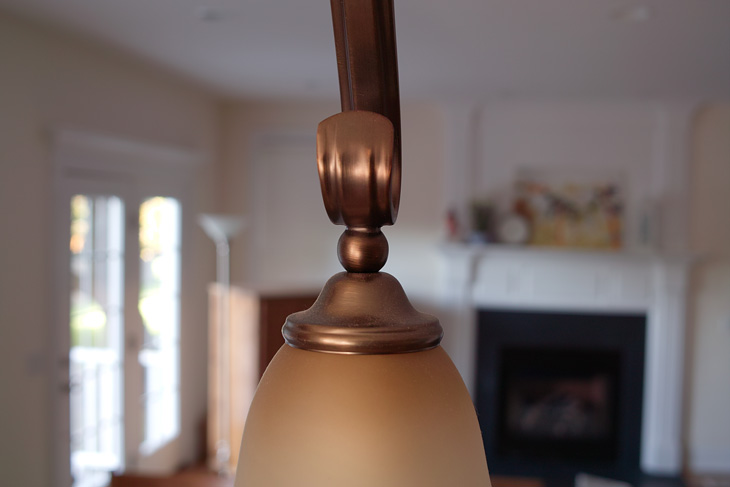
F/2.8: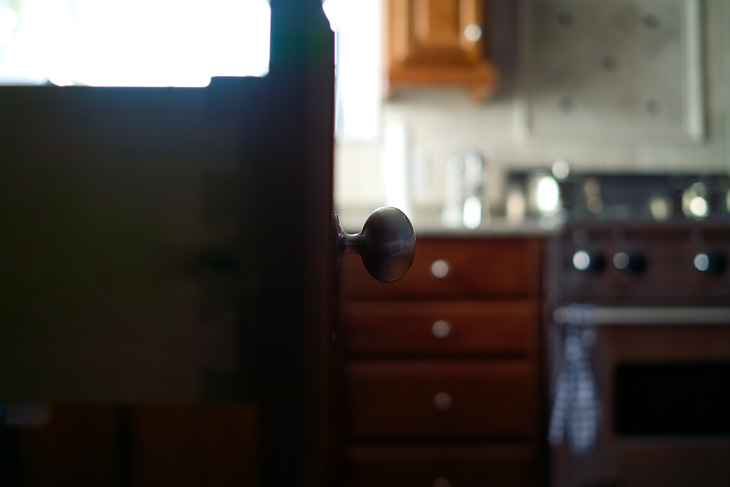
F/4:
Looking at the right side of the frame, you can see how points of light are rendered sharply as heptagons at this aperture. Some blue-green discoloration is also evident in periphery on the wall.
F/5.6: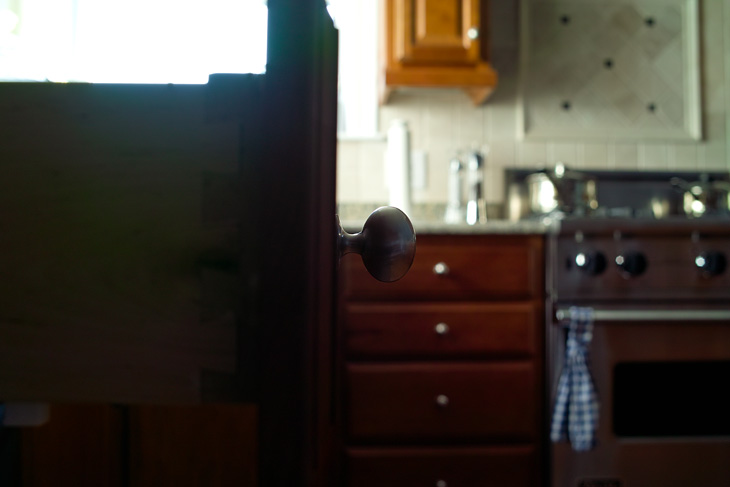
There is the occasional doubling of elements, but overall I find the DP2 bokeh to be neutral and generally pleasing.
The issue of blue-green drift in the corners/periphery was present with the DP1 and effectively addressed in a Sigma Photo Pro update. As of yet, the issue persists with DP2 files but is rarely a major issue and can be addressed in postprocessing. A few examples of color in DP2 photos from a recent day out with the family are shown below (click to enlarge).



Posted by Amin
![]()
Sigma DP2 Shootout Pt. 3 - Dynamic Range
Saturday, September 19, 2009
In Part 3 of the shootout, we'll take a look at how the Sigma DP2 dynamic range compares to that of the Panasonic GH1 and M. Zuiko 17mm f/2.8.
Readers of this site may recall that the DP1 showed superior dynamic range in an earlier shootout, but the GH1 arguably features the latest and greatest Four Thirds sensor technology to date. How will they compare?
I chose a nearly impossible scene for the sake of comparison. At noon, without a cloud in the sky, there is probably no digital camera that can fully handle this dynamic range in a single exposure:

For comparison, we'll be looking specifically at the two regions highlighted by the yellow boxes above.
Test conditions:
- The GH1 was used in 3:2 aspect ratio.
- Subject distance was adjusted to match framing with the two systems.
- GH1 files were processed in Lightroom (latest version) and subsequently downsized using Photoshop Bicubic Sharper to match the native dimensions of the DP2 files.
- DP2 files were processed in Sigma Photo Pro (latest version).
- All settings were left on defaults. White balance was not adjusted to match colors, though I experimented with this and found that doing so did not substantially affect the results.
To begin with, a single RAW file was taken with each camera at ISO 100, f/5.6, and 1/50s.
Here are the crops without any exposure adjustments during RAW processing:
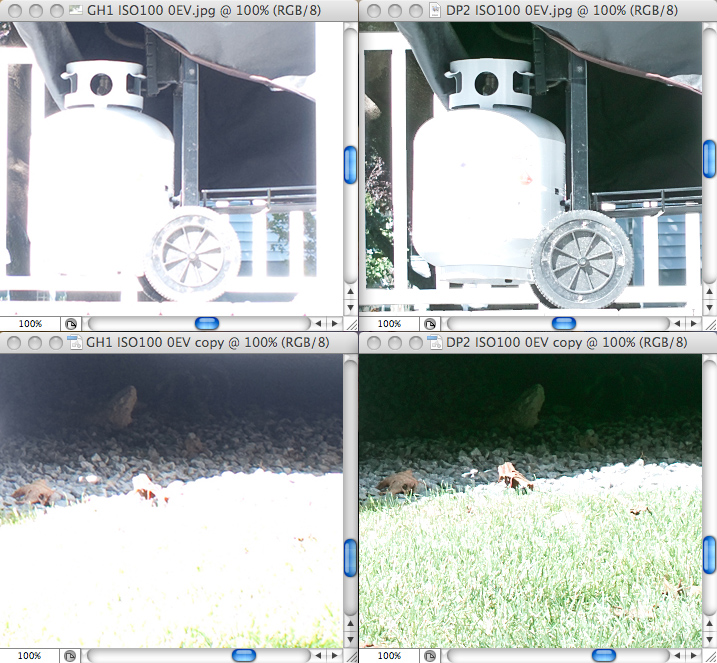
Clearly the DP2 is holding highlights better here. The black points are different, but you can actually see the shadow detail better in the DP2 file. This is evident in the stones under the deck (bottom panel).
Now let's see how much highlight detail can be recovered with a -2EV adjustment during RAW processing:

One possible explanation for the much greater highlight detail in the DP2 file is that what Sigma is calling ISO 100 corresponds to a lower actual ISO than what Panasonic is calling ISO 100. This would result in the DP2 file being underexposed relative to the GH1 file.
If that were the reason for the disparity, we would expect greater usable shadow detail in the GH1 file. Let's see what happens when the same files are pushed to +2EV during RAW conversion:

The greater shadow detail is now even more apparent in the DP2 file.
Conclusion: Under identical circumstances at base ISO, a DP1 RAW file simultaneously delivers greater highlight and greater shadow detail.
Next lets see how the two systems handle the same scene at ISO 400, f/11, 1/50s.
Here are the crops without any exposure adjustments during RAW processing:
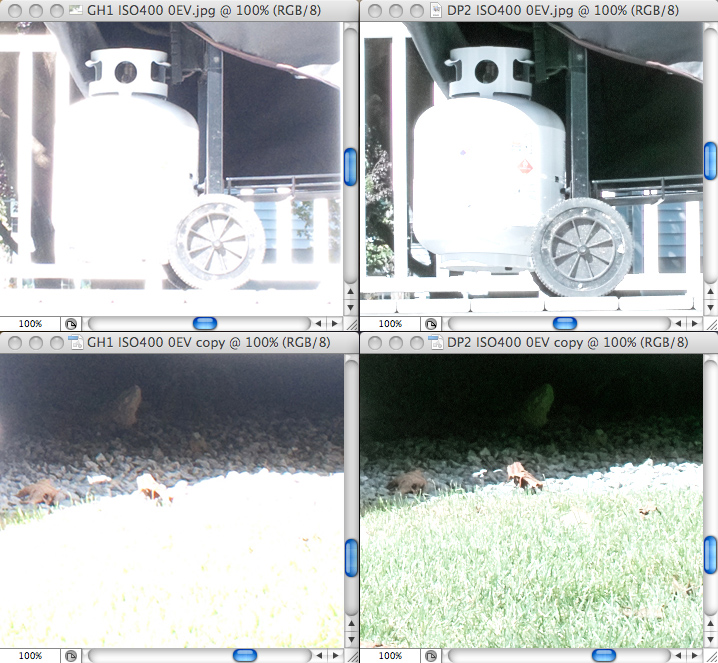
The same files after a -2EV adjustment during RAW conversion:
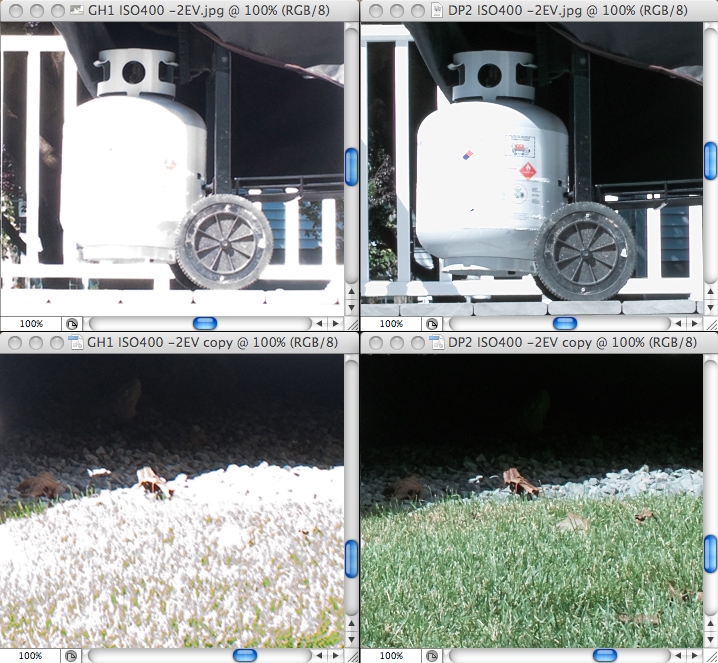
Interesting that the ISO 400 DP2 file with a -2EV adjustment retains more highlight information than the ISO 100 DP2 file with a -2EV adjustment. We saw this in the DP1 shootout as well. It suggests that the high ISO DP files are being (partially or fully) pushed in SPP.
Now the same files after a +2EV adjustment during conversion:
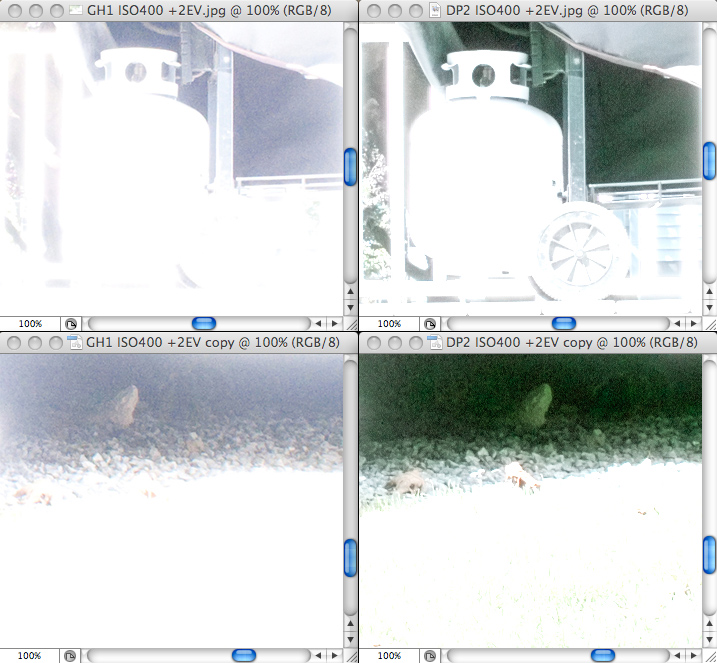
Both files are struggling to produce any usable shadow information here. In the top panel, the DP2 still seems to do better.
The bottom line for ISO 400 is unchanged from the bottom line for ISO 100: better dynamic range from the Sigma.
The RAW files used in this comparison can be downloaded below:
Read More......
Posted by Amin
![]()
New Site for Micro Four Thirds Reviews
Thursday, September 17, 2009
Many in the Serious Compacts community are excited about the new Micro Four Thirds standard. Now there is a site dedicated to nothing but Micro Four Thirds reviews. Check it out at M43reviews.com.
Read More......
Posted by Amin
![]() Labels:
m43,
Micro Four Thirds
Labels:
m43,
Micro Four Thirds
The End of an Era
Wednesday, September 16, 2009
This content has been moved to the new SeriousCompacts.com.
Click here to go to the new location
Posted by Unknown
![]()
Sigma DP2 Shootout Pt. 2 - Detailed Scene
Tuesday, September 15, 2009
In part 2 of the Sigma DP2 shootout, we'll look at how the DP2 lens performs at a variety of apertures and compare the overall detail captured by the DP2 with that of the Panasonic GH1 and Olympus M. Zuiko 17mm f/2.8 lens.
To begin, I'll explain my choice of RAW processors. The DP2 files were processed using Sigma Photo Pro (latest version) because there are no other RAW processors which demosaic DP2 files at this time. The GH1 files, on the other hand, can be processed using a number of different applications. I chose to use Adobe Lightroom (latest version) because it automatically addresses the considerable barrel distortion of the M. Zuiko lens. In doing so, one loses some resolution, and the blurriest extreme corners of the image get cropped out, but overall I think it gives the fairest comparison to the Sigma DP2.
How much do processing decisions affect apparent detail? Here's an example of an f/2.8 center 100% crop processed with Lightroom (right) compared to the same file processed for maximum apparent detail in Raw Developer (left):

Most of the difference there comes down to sharpening, though I do find that Raw Developer squeezes out a touch more detail. This is true for every camera I have tried to date.
Other testing details:
- Subject distance adjusted for roughly the same framing with each camera (greater distance for the longer lens)
- GH1 used in 3:2 aspect ratio
- DP2 files upsized using Genuine Fractals 5 to match the native GH1 picture dimensions
- Tripod, self-timer, base ISO, aperture-priority exposure, good light (high shutter speed)
Even looking at just the resized left half of the scene, there is a clear difference between the DP2 and GH1-17mm files at f/2.8:

Let's look next at the 100% crop comparisons, keeping in mind that the DP2 files have been upsized to match the GH1 file sizes.
f/2.8
Center:
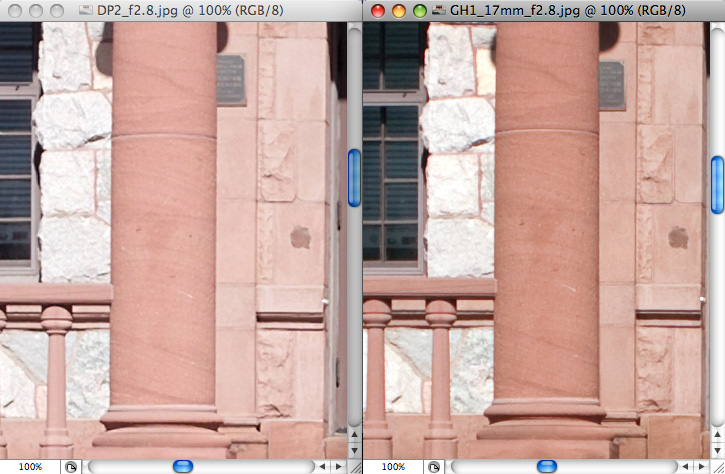
More detail in the GH1 file as would be expected with the higher megapixel sensor.
Near edge:
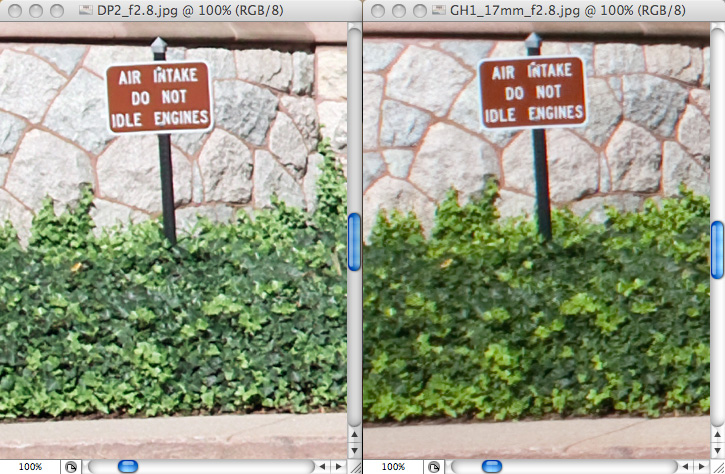
DP2 outclassing the M. Zuiko here and also showing greater lens contrast. There is some color fringing in the GH1 crop.
Extreme corner:
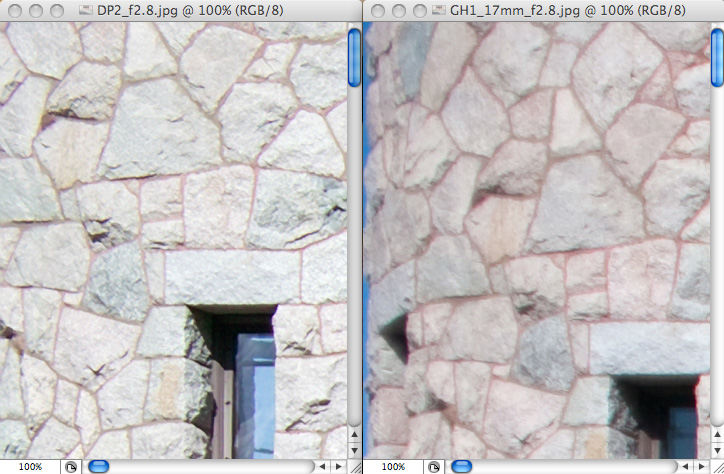
Impressive wide open performance from the DP2 in the extreme corner of the frame while the M. Zuiko lags far behind. Again there is some color fringing in the GH1 crop.
f/4
Center:

GH1-17mm looking very good here with the lens resolving sufficiently to take advantage of the higher megapixel sensor.
Near edge:
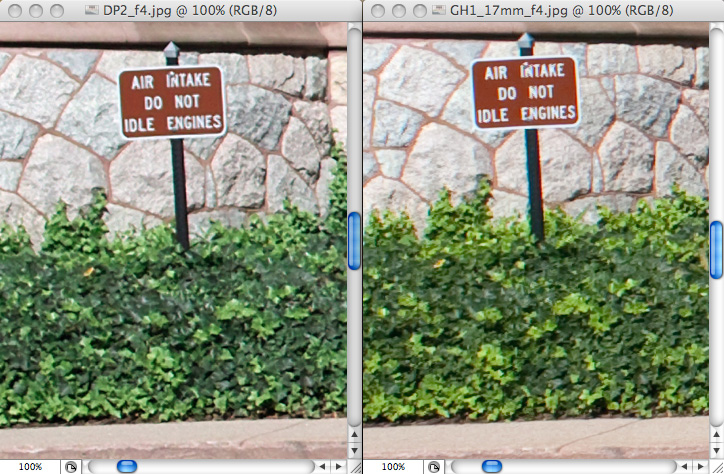
Zuiko has caught up here in peripheral performance.
Extreme corner:
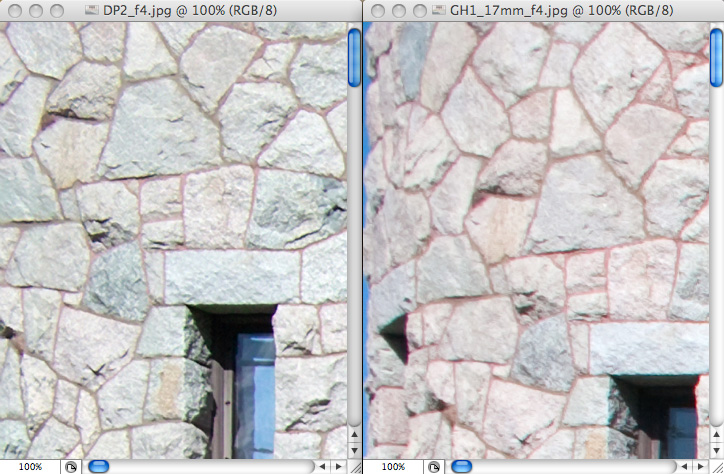
The Zuiko has improved but has a ways to go still.
f/5.6
Center:

As expected, the higher GH1 sensor is still capturing more detail at this aperture.
Near edge:
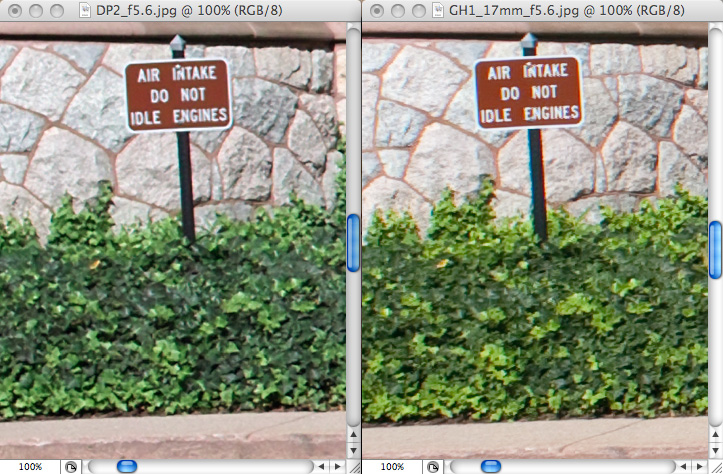
Still very close in this zone.
Extreme corner:
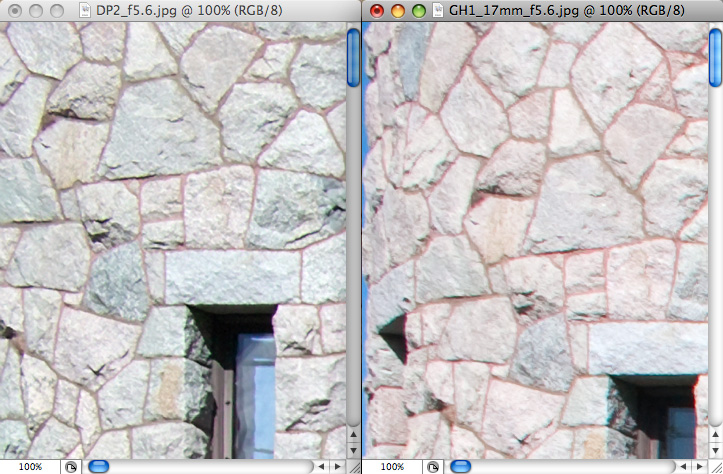
DP2 still has an edge in the extreme corner.
f/8
Center:

GH1-17mm still has an edge, but diffraction is bring the level of detail down closer to that of the DP2.
Near edge:

DP2 looks the better of the two here.
Extreme corner:
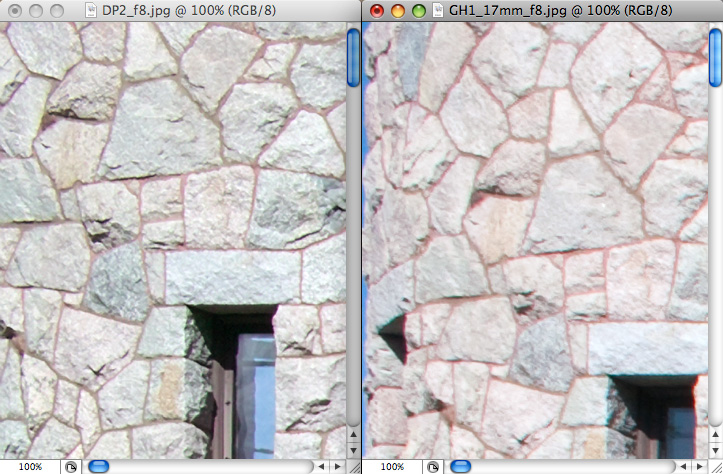
DP2 is clearly better.
Conclusions:
- The Sigma DP2 lens has balanced performance across the frame wide open at f/2.8, and by f/4 even the extreme corner peformance is quite good. Anything less would have been a disappointment given the precedent set by the outstanding DP1 lens.
- The M. Zuiko 17mm lens leverages the GH1 sensor potential in the center of the frame from f/2.8, puts in a decent peripheral performance stopped down to f/4 or f/5.6, but never quite nails the extreme corner.
- Softening due to diffraction is evident at f/8 with the Micro Four Thirds kit and not with the DP2.
- There seems to be higher lens contrast with the DP2 although the contribution of processing by Sigma Photo Pro cannot be ascertained. Application of wide-radius unsharp mask to a GH1 file gives it a similar look to that of the DP2 files.
Posted by Amin
![]() Labels:
shootout,
Sigma DP2
Labels:
shootout,
Sigma DP2
Short Ricoh GR Digital 3 impression
Monday, September 14, 2009
By Wouter Brandsma
While Amin is working on a Ricoh GR Digital III test sample and comparing it with other cameras I received a test sample from Ricoh Europe. My aim is to come up with a similar written impression of this camera like I did with the GX100 and the GX200. I will post a more lengthly impression of the new Ricoh GR Digital III soon, but I thought it wouldn’t harm to write down some first impressions of this camera.
I always thought that my Ricoh GX200 felt like a quality camera, well to be honest it still is, but the GRD is certainly a step beyond that. The camera has a lovely, quality feel with a nice non-slippery finish as a result of the magnesium body. The camera has the typical Ricoh handgrip and all buttons are logically placed, almost logical in fact, but more about that later.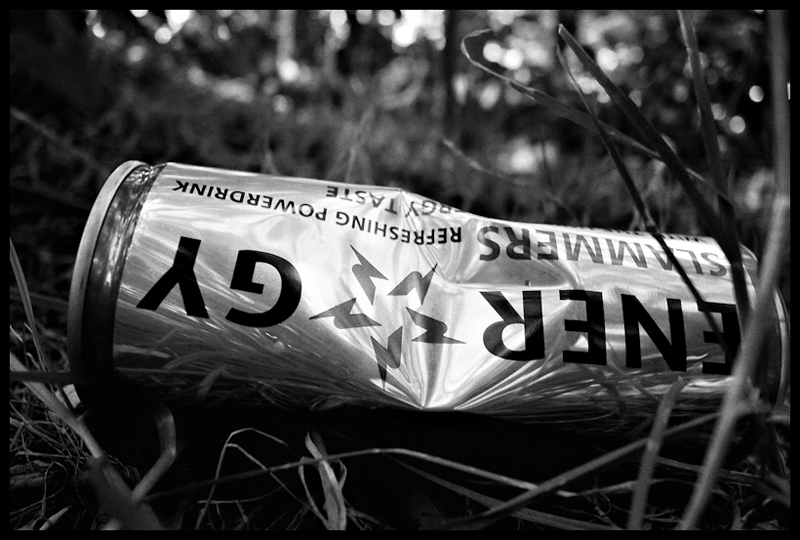
I have never had any other Ricoh GR Digital camera although I have certainly considered it. Eventually I chose the Ricoh GX100 in 2007, because of the stepped zoom lens. Making it slightly more versatile. I still think I should have followed my heart and should have picked up the GR Digital I though. So remember this! Even though many consider reviews by professional reviewers the bench mark for the scientific proof of the quality of a camera, I have learned to be completely in rational with regard to deciding cameras. In the end you are going to take the pictures with it and you will use and push the camera beyond the brick walls and color charts at different ISO's. Real world is totally different in my opinion.
I still have the original GR camera though, the Ricoh GR1 which became a true cult camera, in particular in Japan. The most distinctive features of the GR series are the lightweight magnesium body, a high class 28mm lens and easy to use handling. And to me, the Ricoh GR Digital III forms no exception.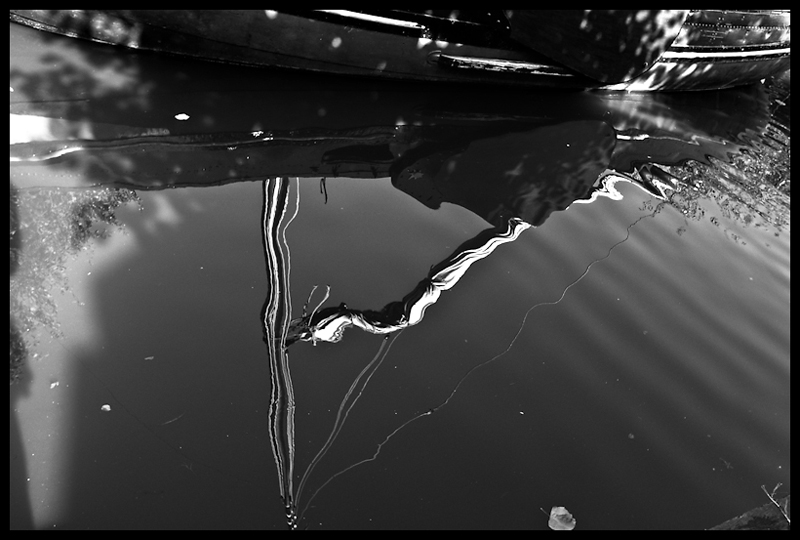
From the outside the camera hardly differs from the other GR Digitals. It is only a bit larger to host the slightly larger sensor. And on the rear you will notice the larger 3" LCD screen with 920,000 dots. Also this third generation GR Digital has no optical viewfinder. Now some say that we should live with that. A fact of life for small compact cameras, but I much rather prefer a smaller LCD screen and a little increase in camera body height to accommodate a nice bright viewfinder. But I guess I am old school. Therefore I requested Ricoh to supply the camera with an optical viewfinder. I asked for the GV-1 viewfinder which is quite large and not only has the frame lines for 28mm, but also for 21mm to match the view with the GW-2 21mm Wide Conversion Lens. Probably due to huge demand in Japan Ricoh doesn't have the wide conversion lens in stock now, but I hope I will get before I finished testing this camera.
While mentioning the supply difficulties of the GW-2 I should mention too that Ricoh was completely surprised by the pre-sales in Japan. These were much larger than anticipated and was part too of the reason to offset the sale date basically everywhere else. The camera is now on sale pretty much anywhere, although I haven't seen this camera available in the Netherlands, where I live, yet (mid September).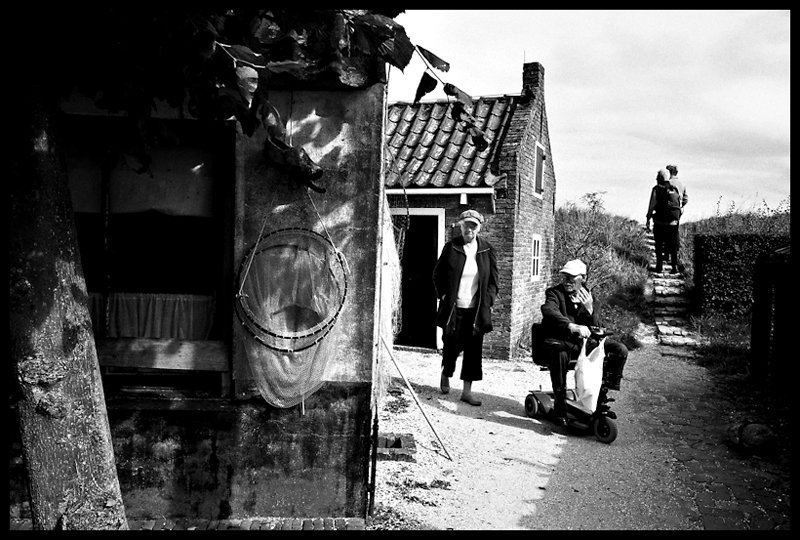
Like Panasonic with the LX3 and Canon with the new G11 Ricoh was able to get a new sensor that has less pixels than the previous version. In combination with the better in-camera image engine and the fast lens, this will improve the low light capabilities and high ISO performance. This is an important change in the market of serious compacts and I hope it will be followed by others. But what makes this camera unlike any other compact camera is the new 28mm lens with a maximum opening of f/1.9. It used to be f/2.4 (thank you Fabian)! An outstanding technical achievement in my opinion.
So, before this short impression ends up being a longer impression I will sum up some of my likes and dislikes with the new Ricoh GR Digital III.
Likes
Overall speaking I really like this camera. The feel and the handling makes it very special. In combination with the large and bright GV-1 viewfinder it is a joy to use. I can fully understand why the pre-sales where so high in Japan. Using this camera reminds me picking up the GR1 for the first time when I got it to replace my SLR. For me it still is a cult camera with all the subjective feelings that contribute for me to that status.
The best of all is the new lens. Such a fast lens is a bonus for low light and with the better high ISO performance I have had no problems using this camera at higher ISO's, even up to ISO 1600. That is something I never did with the GX200, because of all the noise and banding.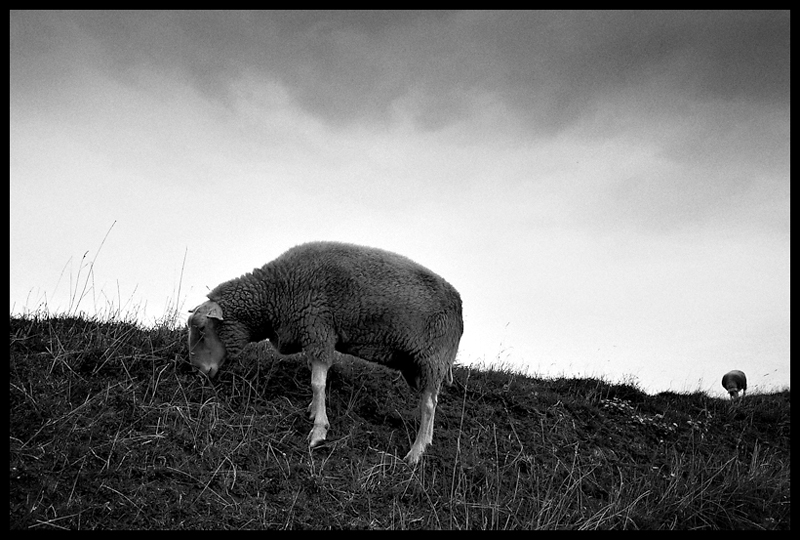
Dislikes
There is no perfection in my opinion and also the GRDIII reminds me of that. Quality comes at a price and Amazon prices the GRDIII for $699. That sure is a lot of money in my opinion, but it is a cult camera with superb built quality, top materials, and a stellar lens. While some love the new 3" LCD screen, because they only photograph with the LCD screen. It is just too large for me. To get such a large sensor in the body they had to move the buttons further to the right rear section of the camera. Although they glad fully didn't change the button lay-out I regularly hit the display and macro button with my right thumb. Something that never happens to me with the GX200.
I leave it for here and will continue evaluating this camera for some time. I hope to post my final impressions of this camera by the end of this month. Interested to read more about this camera? You might want to check out the Ricoh site.
All photographs by Wouter Brandsma
Posted by Wouter Brandsma
![]() Labels:
impression,
Ricoh,
Ricoh GRDIII
Labels:
impression,
Ricoh,
Ricoh GRDIII
2010 Micro Four Thirds Lens Roadmap: What's Missing?
Sunday, September 13, 2009
With any new system, it is impossible to cover all lens needs right away. Thus manufacturers need to prioritize according to commonly used lens types and market demand.
Here's what we have so far for Micro Four Thirds:
Ultra-wide:
- Lumix 7-14mm f/4 (difficult to locate in United States)
- Lumix 8mm f/3.5 (fisheye, due in 2010)
- M. Zuiko 17mm f/2.8
- Lumix 14mm f/2.8 (due in 2010)
- Lumix 20mm f/1.7 (due soon)
- M. Zuiko 14-42mm f/3.5-5.6
- Lumix 14-45mm f/3.5-5.6 O.I.S.
- Lumix HD 14-140mm f/4-5.8 O.I.S.
- Lumix 45-200mm f/4-5.6 O.I.S.
- Lumix 100-300mm f/4-5.6 O.I.S.
- Leica DG Macro-Elmarit 45mm f/2.8 O.I.S. (1:1 macro, due soon)
What I'd like to see is a high quality optic with the following characteristics:
- Fixed focal length between 37.5mm and 67.5mm
- At least f/1.8 speed and preferably f/1.4
- Quick autofocus
Posted by Amin
![]()
Sigma DP2 Shootout Pt. 1 - Form and Function
Saturday, September 12, 2009
Size
Sigma created the category of large-sensor compact camera and presently remain the only company with a fixed lens large-sensor camera on the market. Amongst all current large-sensor cameras, the DP2 is the second most compact, closely following the DP1.
In contrast to any Micro 4/3 camera-lens combo, a DP2 without hood or accessory optical viewfinder (OVF) will fit in a standard pants pocket. However, the DP2 is no shirt pocket camera.
Here's how the DP2 compares in size and shape with an advanced small sensor compact, the Ricoh GR Digital (GRD) III:


Compared to the Panasonic GH1 and M. Zuiko 17mm f/2.8:


Keep in mind that the DP2 sensor is intermediate in size between that of a Micro 4/3 camera and that of a 1.5x crop APS-C camera such as that of Samsung NX or Nikon APS-C.
Lets see how the DP2 compares in size to a small Nikon APS-C rig:

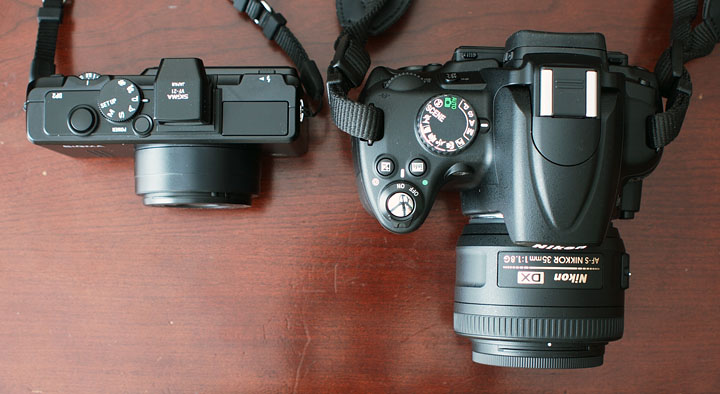
Build quality
The Sigma DP2 is extremely light when compared to any Micro Four Thirds combination and featherweight in comparison to any DSLR gear. This has led a number of observers to state that it feels "cheap". Likely the nondescript looks also contribute to this assessment. In contrast, I appreciate the lack of weight hanging around my neck and don't find anything wanting in the DP2 build quality. There is no give or creak in the DP2 body. Dials, controls, and battery door are all solid. Accessories such as the optional OVF and hood snap are likewise nicely fitted.
Look and sound
With regards to looks, Sigma has chosen a serious and discreet appearance. I'd prefer something with a bit more flair, but many will prefer the staid DP.
Like the DP1, the DP2 makes an unpleasant noise when extending the lens and is a bit noisier than I'd like when autofocusing. The shutter click is very quiet and unlikely to be noticed.
Controls and usability
The DP2 is boxy, but I find it very comfortable to grip and use for an extended period. Controls are well designed though not outstanding. Compare to the recently announced Leica X1 (images carefully resized to proper scale):
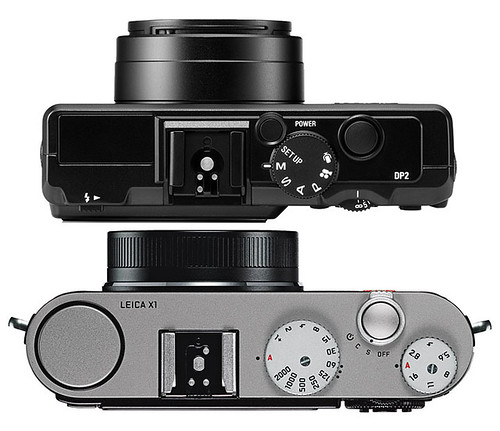
To give the DP2 its due, the primary apparent exposure parameters - aperture, shutter speed, and ISO - are all readily available during use of the camera, which is more than I can say for a number of serious compacts. In manual exposure mode, the rocker switch controls shutter speed which the left/right buttons (on the four way controller) determine aperture settings. In aperture priority mode, the rocker controls aperture, and left/right controls exposure compensation. The 'QS' button gives rapid access to ISO control. Simple and effective. One niggle is that auto ISO will select only from ISO 100-400. I would prefer to be able to choose the top ISO as is possible on the GH1 and D5000.
The LCD display, widely criticized with the DP1, remains below average for a camera of this class. It's not a show stopper for me, but a better LCD would be welcome. Here you can see the LCD of the DP1 (left) compared with that of the GRD III (right) with both at their default brightness:
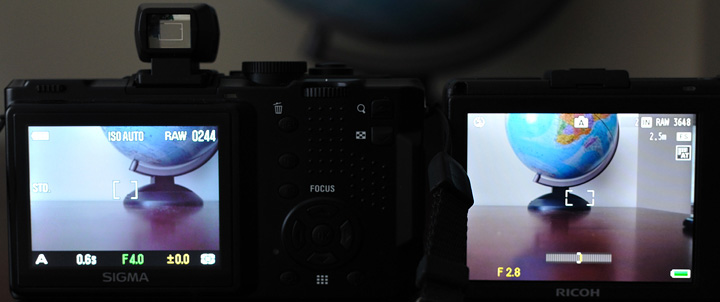
Operational speed
Autofocus remains on the slow side, slower than that of the GH1 with M. Zuiko 17mm lens (which itself doesn't focus as quickly as the G1 kit zoom) and slower also than the GRD III. The DP2 focus also struggles more in low light than those other two cameras. That said, the DP2 focus is accurate and is quicker when one limits the focus range to farther distances by selecting the landscape focus mode. As with the DP1, a focus confirmation light is visible without removing one's eye from the OVF.
Manual focus is well implemented. I prefer the DP2 focus wheel to the manual focus implementation on the GH1 or GRD III because there is a visible, palpable control by which one can reliably scale focus at medium and small aperture settings.
Pressing the 'OK' button (with the latest firmware) gives a magnified view for manual focus. I'd prefer if Sigma would have the display automatically present a magnified view whenever the manual focus dial is turned, as is the case by default with the GH1. However the current DP2 implementation is very good.
The buffer has been improved from that of the DP1. One can now take photos in RAW with a shot-to-shot time of approximately 2.5 seconds, which is short enough for me although a two shot buffer without waiting would be even better.
In Part 2 of this shootout-based review, we'll take a look at lens performance.
Posted by Amin
![]()
Recent Posts
-
▼
2009
(119)
-
▼
September
(19)
- GRD III Impressions / Review at Wouter Brandsma Ph...
- Face Detection
- Panasonic Lumix 20mm f/1.7 Review at DPReview
- Featured Photographer: Vern Dewit
- Sigma DP2 Shootout Supplement: Bokeh
- Sigma DP2 Shootout Pt. 3 - Dynamic Range
- New Site for Micro Four Thirds Reviews
- The End of an Era
- Sigma DP2 Shootout Pt. 2 - Detailed Scene
- Short Ricoh GR Digital 3 impression
- 2010 Micro Four Thirds Lens Roadmap: What's Missing?
- Sigma DP2 Shootout Pt. 1 - Form and Function
- Update on the Sigma DP2 - Olympus E-P1 Shootout
- E-P1 - GH1 Size Comparison
- Leica M9 ISO Test at Focus Numerique
- Leica X1: A Digital Hexar AF?
- Direct View Interchangeable Lens (DVIL): The Devil...
- Which Micro Four Thirds: A Personal Rationalization
- It's Official: Panasonic GF1
-
▼
September
(19)


